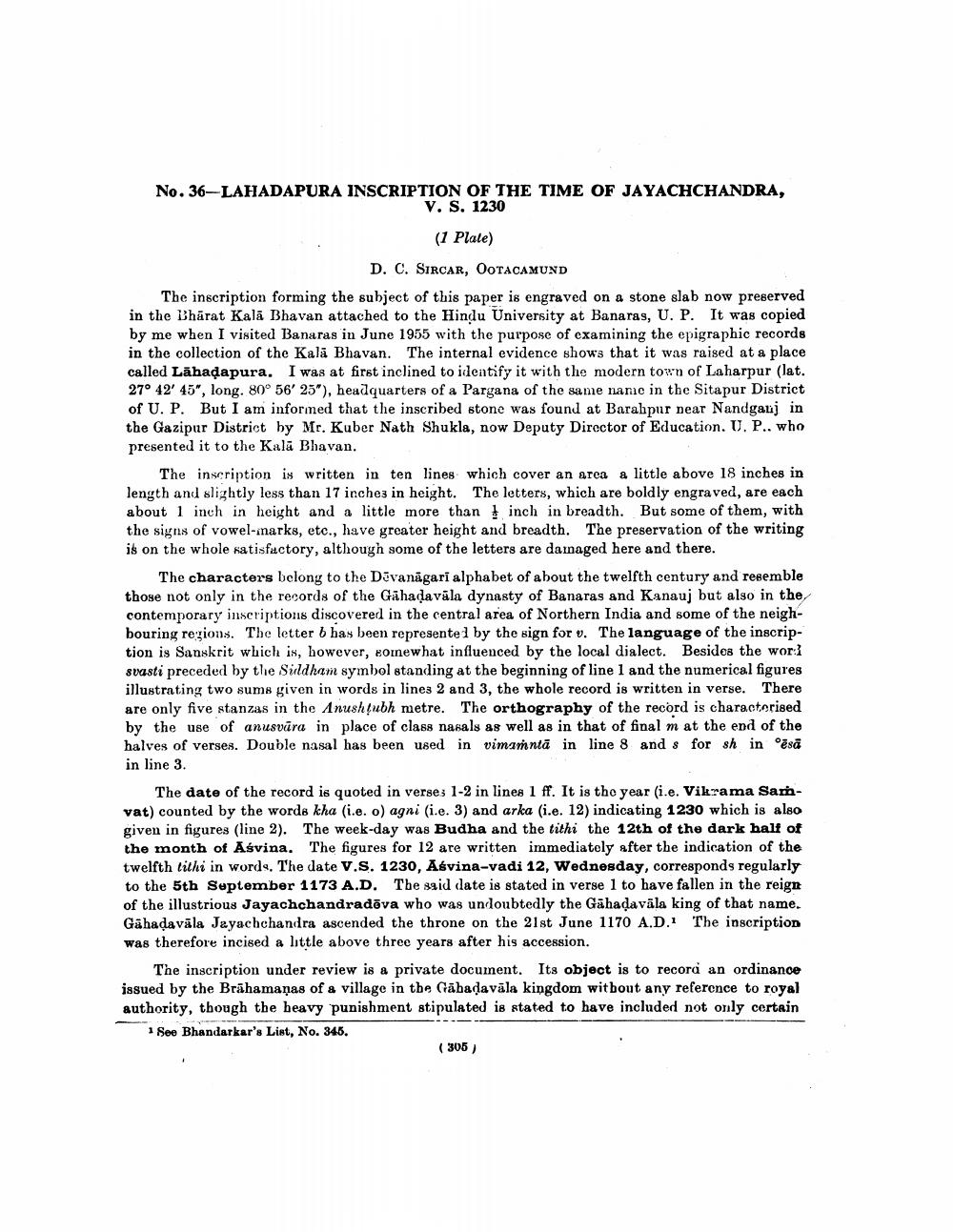________________
No. 36-LAHADAPURA INSCRIPTION OF THE TIME OF JAYACHCHANDRA,
V. S. 1230
(1 Plate)
D. C. SIRCAR, OOTACAMUND The inscription forming the subject of this paper is engraved on a stone slab now preserved in the Bhārat Kalā Bhavan attached to the Hindu University at Banaras, U. P. It was copied by me when I visited Banaras in June 1955 with the purpose of examining the epigraphic records in the collection of the Kala Bhavan. The internal evidence shows that it was raised at a place called Lāhadapura. I was at first inclined to identify it with the modern town of Laharpur (lat. 27° 42' 45", long. 80° 56' 25"), headquarters of a Pargana of the same name in the Sitapur District of U. P. But I am informed that the inscribed stone was found at Barahpur near Nandganj in the Gazipur District by Mr. Kuber Nath Shukla, now Deputy Director of Education. U. P., who presented it to the Kala Bhavan.
The inscription is written in ten lines which cover an area a little above 18 inches in length and slightly less than 17 inches in height. The letters, which are boldly engraved, are each about 1 inch in height and a little more than inch in breadth. But some of them, with the signs of vowel-inarks, etc., have greater height and breadth. The preservation of the writing is on the whole satisfactory, although some of the letters are damaged here and there.
The characters belong to the Dāvanāgari alphabet of about the twelfth century and resemble those not only in the records of the Gahadavāla dynasty of Banaras and Kanauj but also in the contemporary inscriptions discovered in the central area of Northern India and some of the neighbouring regions. The letter 6 has been represented by the sign for v. The language of the inscription is Sanskrit which is, however, somewhat influenced by the local dialect. Besides the wor: svasti preceded by the Suldham symbol standing at the beginning of line 1 and the numerical figures illustrating two suma given in words in lines 2 and 3, the whole record is written in verse. There are only five stanzas in the Anushubh metre. The orthography of the record is characterised by the use of anusvura in place of class nasals as well as in that of final m at the end of the halves of verses. Double nasal has been used in vimannta in line 8 and s for sh in Cēsā in line 3
The date of the record is quoted in verse: 1-2 in lines 1 ff. It is the year (i.e. Vikrama Samvat) counted by the words kha (i.e. o) agni (i.e. 3) and arka (i.e. 12) indicating 1230 which is also given in figures (line 2). The week-day was Budha and the tithi the 12th of the dark half of the month of Aśvina. The figures for 12 are written immediately after the indication of the twelfth tithi in words. The date V.S. 1230, Asvina-vadi 12, Wednesday, corresponds regularly to the 5th September 1173 A.D. The said date is stated in verse 1 to have fallen in the reign of the illustrious Jayachchandradova who was undoubtedly the Gähadavāla king of that name. Gähadavāla Jayachchandra ascended the throne on the 21st June 1170 A.D. The inscription was therefore incised a little above three years after his accession.
The inscription under review is a private document. Its object is to record an ordinance issued by the Brāhamaņas of & village in the Cābadavāla kingdom witbout any reference to royal authority, though the heavy punishment stipulated is stated to have included not only certain 1 See Bhandarkar's List, No. 345.
(305)




